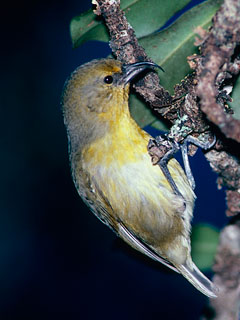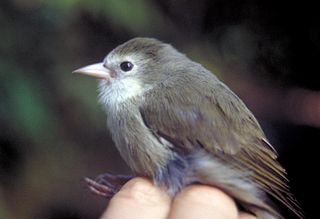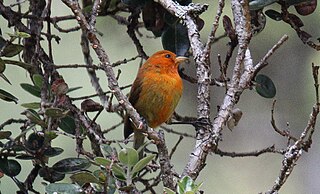
The Hawaiian crow or ʻalalā is a species of bird in the crow family, Corvidae, that is currently extinct in the wild, though reintroduction programs are underway. It is about the size of the carrion crow at 48–50 cm (19–20 in) in length, but with more rounded wings and a much thicker bill. It has soft, brownish-black plumage and long, bristly throat feathers; the feet, legs, and bill are black. Today, the Hawaiian crow is considered the most endangered of the family Corvidae. They are recorded to have lived up to 18 years in the wild, and 28 years in captivity. Some Native Hawaiians consider the Hawaiian crow an ʻaumakua.

The ʻiʻiwi or scarlet honeycreeper is a species of Hawaiian honeycreeper. The ʻiʻiwi is a highly recognizable symbol of Hawaiʻi. The ʻiʻiwi is one of the most common endemic birds of the Hawaiian Islands.

The poʻo-uli or Hawaiian black-faced honeycreeper is an extinct species of passerine bird that was endemic to the island of Maui in Hawaiʻi. It is considered to be a member of the Hawaiian honeycreepers, and is the only member of its genus Melamprosops. It had a black head, brown upper parts and pale gray underparts. This bird inhabited only the wetter, easternmost side of Maui, where it had rapidly decreased in numbers. With extinction threatening, efforts were made to capture birds to enable them to breed in captivity. These efforts were unsuccessful; in 2004, only two known birds remained, and since then, no further birds have been sighted. A 2018 study recommended declaring the species extinct, citing bird population decline patterns and the lack of any confirmed sightings since 2004, and in 2019, the species was declared extinct.

The ʻōʻū is a species of Hawaiian honeycreeper endemic to the Hawaiian islands. It has a dark green back and olive green underparts; males have a yellow head while females have a green head. Its unusual beak seems to be adapted to feeding on the fruits of Freycinetia arborea. It has a strong flight which it uses to fly considerable distances in search of this vine, but it will eat other fruits, buds, flowers and insects.

The Alakaʻi Wilderness Preserve, popularly known as Alakaʻi Swamp, is a montane wet forest on the Hawaiian island of Kauaʻi. Although the preserve is home to alpine bogs, it is not a true swamp. It is located on a plateau near Mount Waiʻaleʻale, one of the wettest spots on Earth. Due to its unique combination of high elevation and climate, the Alakaʻi Swamp harbors a large number of endangered endemic species that are only found in this area and whose population has been dramatically declining over the last decades. It is designated as a IUCN protected area.

Avian malaria is a parasitic disease of birds, caused by parasite species belonging to the genera Plasmodium and Hemoproteus. The disease is transmitted by a dipteran vector including mosquitoes in the case of Plasmodium parasites and biting midges for Hemoproteus. The range of symptoms and effects of the parasite on its bird hosts is very wide, from asymptomatic cases to drastic population declines due to the disease, as is the case of the Hawaiian honeycreepers. The diversity of parasites is large, as it is estimated that there are approximately as many parasites as there are species of hosts. As research on human malaria parasites became difficult, Dr. Ross studied avian malaria parasites. Co-speciation and host switching events have contributed to the broad range of hosts that these parasites can infect, causing avian malaria to be a widespread global disease, found everywhere except Antarctica.

The Kauai ʻakialoa was a Hawaiian honeycreeper in the subfamily Carduelinae of the family Fringillidae. It was endemic to the island of Kauai, Hawaii. It became extinct in the 20th century due to introduced avian disease and habitat loss. The Kauai ʻakialoa was about seven and a half inches in length and had a very long downcurved bill, which covered one third of its length. The adult males were bright olive-yellow on top and yellow on the bottom. The throat, breast, and sides of the body were olive-yellow. The females, however, were green-gray above and had a shorter bill.

The Oʻahu ʻamakihi is a species of Hawaiian honeycreeper in the family Fringillidae. The male is rich yellow below, sharply contrasted with greenish upper parts. Females are duller and have two prominent wing-bars. It has a total length of approximately 4.5 inches (11 cm). It is endemic to the island of Oʻahu in Hawaiʻi, and is likely the only surviving honeycreeper endemic to the island.

The ʻakiapōlāʻau, pronounced ah-kee-ah-POH-LAH-OW, is a species of Hawaiian honeycreeper that is endemic to the island of Hawaii. Its natural habitats are dry and montane moist forests, and the only bird species on the island to occupy the woodpecker niche. The bird is 5.5 inches (14 cm) in length, and has an unusually curved beak-(a specialist species). The ʻakiapolaʻau is a pudgy bird which has a whitish bottom and tail, black legs, yellow chest, orangish head, black face mask and bill and gray black wings. The male's song is either a loud, short pit-er-ieu or a rapid warba-warba. Its various calls include an upslurred whistle, a short cheedle-ee warble, and a short sweet. Due to the recent disappearance of the Kauai nukupuʻu in the 1900s and the Maui nukupuʻu in the 1990s, leading to fears that they may be extinct, the ʻakiapōlāʻau may be the last of its genus. It is the only member of the subgenus Heterorhynchus, which has a woodpecker-like feeding habitat and exclusively preys on insects, in contrast to the nukupu'us, which were both insect-eaters and also hummingbird-like nectarivores.

The Hawaiʻi ʻamakihi, also known as the common ʻamakihi, is a species of Hawaiian honeycreeper.

The ʻapapane is a small, crimson species of Hawaiian honeycreeper endemic to the Hawaiian Islands. They are the most abundant and widely distributed honeycreeper and are found on the islands of Hawaiʻi, Maui, Lānaʻi, Kauaʻi, Molokaʻi and Oʻahu.

The ʻakekeʻe or Kaua'i 'akepa is a bird species in the family Fringillidae, where it is placed in the Hawaiian honeycreeper genus Loxops. It is endemic to the island of Kauaʻi where it is found in small numbers in higher elevations. Because of their similar size, shape, and unusual bill, the ʻakekeʻe and the ʻakepa were for some time classified as a single species. This was eventually changed, because of differences in their color, nesting behavior, and calls. The 'akeke'e is extremely threatened and is predicted to face imminent extinction if mosquito control efforts on Kaua'i are not implemented.

The ʻakikiki, also called the Kauaʻi creeper, is a critically endangered Hawaiian honeycreeper endemic to Kauaʻi, Hawaiʻi. It is the only member of the genus Oreomystis. Of the Hawaiian birds known to be extant, it is thought to be the most endangered, with only 454 wild individuals known as of 2018. A survey report in 2021 estimated the population at 45 with a 5 percent annual decrease, and in July 2023 the remaining number of wild birds was estimated to be just 5 individuals. This species is predicted to be extinct in the wild in 2023.

The ʻākohekohe, or crested honeycreeper, is a species of Hawaiian honeycreeper. It is endemic to the island of Maui in Hawaiʻi. The ʻākohekohe is susceptible to mosquito‐transmitted avian malaria and only breeds in high‐elevation wet forests.

The Maui ʻalauahio, also known as the Maui Nui ʻalauahio or Maui creeper, is a species of Hawaiian honeycreeper. It is endemic to Maui Nui, Hawaii. The name Maui ʻalauahio is somewhat misleading because the species seems to have occurred on most, if not all, parts of the ancient Maui Nui, which includes the present day islands of Maui, Molokaʻi, Lānaʻi, and Kahoʻolawe. There are two subspecies: the Lānaʻi ʻalauahio, P. montana montana, which occurred on Lānaʻi (extinct); and P. montana newtoni which occurs on Maui. The common name refers to both groups.

The kiwikiu or Maui parrotbill is a species of Hawaiian honeycreeper endemic to the island of Maui in Hawaii. It can only be found in 50 square kilometres (19 sq mi) of mesic and wet forests at 1,200–2,150 metres (3,940–7,050 ft) on the windward slopes of Haleakalā. This species is critically endangered, with an estimated population in 2016 of 250-540 individuals, but more recent estimates of less than 150 individuals. Fossil evidence indicates that the bird could at one time be seen in dry forests at elevations as low as 200–300 metres (660–980 ft), as well as on the island of Molokaʻi.

The greater koa finch is an extinct species of Hawaiian honeycreeper in the subfamily Carduelinae of the family Fringillidae. It was endemic to the island of Hawaiʻi.
The highland finch is an extinct member of the Fringillidae and a Hawaiian honeycreeper which is known only from a few bones found in caves. It is the only member of the genus Orthiospiza. It was endemic to the high-elevation areas of Mount Haleakalā on the Hawaiian island of Maui. It has been speculated that they were pushed to extinction because of habitat loss. It is known only from fossil remains and likely became extinct before the first Europeans arrived in 1778.

The Maui nukupuʻu is a species of nukupuʻu Hawaiian honeycreeper that was endemic to the island of Maui in the Hawaiian Islands. The small, five-inch-long bird lived only in eastern Maui, where it was dependent on high-elevation mesic and wet forests of ʻōhiʻa lehua and koa. These two species of trees attract insects, causing the Maui nukupuʻu to have a higher chance of finding a meal near these trees. It was last sighted in the late 1990's, and is most likely extinct.

The Hawaiʻi ʻakepa is an endangered ʻakepa native to Hawaiʻi in the Hawaiian Islands. All three of the ʻakepa were considered monotypic before being split by the NACC of the AOU in 2015. The Hawaii ʻakepa was first collected by western science during Captain James Cook's third voyage around the world. Several specimens were collected, as well as feather leis constructed by Hawaiian artisans. The specimens were classified when brought back to England several years later. The Latin name of the bird, Loxops coccineus, means "crossed" (Loxops) and "red" (coccineus).
























